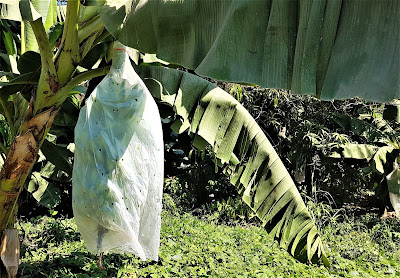Tuesday, January 17, 2017
going bananas
What do you do while pondering how to remove a flat tire?
Last Wednesday, a rock in the road gave me the opportunity to consider such philosophical questions. (moving to mexico -- driving the demons). When I tried to change the resulting flat tire, I discovered that local tire shops using wrong-sized wrenches to remove my lug nuts had deformed the soft metal caps on some of my nuts. No matter how I tried, my wrench would not fit on two of them.
While considering my options, I decided to do something I have long wanted to do. During the eight years I have lived here, I have driven past acres of banana plantations wondering what it would be like to wander through the seemingly-endless rows.
It is easy to pick up information about bananas around here. Some of it is even accurate.
Bananas do not grow on trees. They grow on plants. The difference is important because only one stalk of bananas grows on each plant. When the stalk is cut, there is no more need for the plant. It has served its duty and will receive the Marie Antoinette treatment right at the ground.
Commercial bananas do not reproduce sexually. They are all clones of one another. Once a banana plant is in the ground, it will propagate through shoots from the sister plant.
One of the weaknesses of cloned plants is their susceptibility to disease. Once a disease starts in one banana plant, the entire stock of that variety will eventually die. That is currently occuring to the most common commercial variety, the Cavendish. No one is certain when the variety will die out. But it will be soon. Fortunately, other varieties are waiting in the wings.
And, if you need bar bet material, this one should put pesos in your pants. Bananas are part of the berry family. That is, if you speak Botanese.
But none of that was going through my mind as I started my little trek through the bananas. When you are wandering through what appears to be a magical place, the science simply does not matter.
The banana body bags hanging over each stalk look even more eerie than they do when I am zooming past on the road. Up close, they appear to be right out of The Pod People.
Of course, they are not. Or, at least, I escaped without being subsumed into an alien form.
The first question visitors ask me is the purpose for the bags. Depending on who you ask, there appear to be at least three purposes.
The first has always struck me as a bit odd -- to provide a micro-climate to enhance the ripening of the bananas. That seems odd because our tropical climate would appear to offer the perfect macro-climate to ripen bananas. But I heard it from a grower. So, credit it how you will.
The second is the most frequent response -- to protect the fruit from the various pests that find bananas enticing. And they are legion. The covers are either impregnated with insecticides or a chemical strip is inserted into the bag to cut down on the loss to caterpillars, beetles, and a host of insects.
The third is quite intuitive. The bag acts as protection against fruit damage from the stem and leaves when the wind catches the banana bunch. The wind here is frequently strong enough to fling my paintings on the ground. Bananas are a bit more fragile.
But there I go again with the science. You don't need to know any of that to spend a short strioll through the bananas.
Like most aesthetic experiences, it is often better to not even know that there is such a thing as the scientific method.
Subscribe to:
Post Comments (Atom)


No comments:
Post a Comment